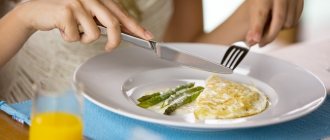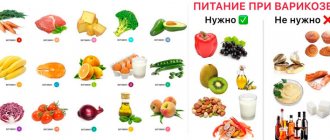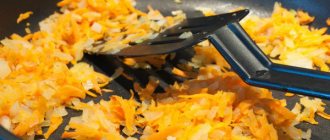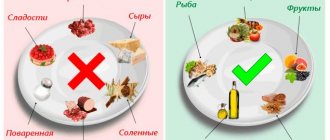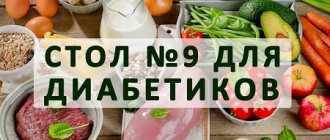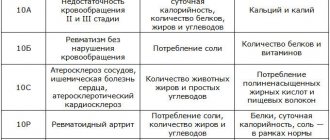Indications for use.
Therapeutic diet No. 9 according to Pevzner is recommended for people with type II diabetes mellitus. Most often, this disease affects people over the age of 40, that is, in adulthood, which is associated in particular with poor nutrition. The goal of diet No. 9 is to create conditions in the body that promote normal carbohydrate metabolism.
Nutritional features.
Nutrition according to table No. 9 is a diet with a restriction, first of all, of animal fats and carbohydrates, while maintaining the physiological norm of vitamins and minerals. Products and dishes that contain a lot of sugar, such as jam or confectionery, are completely excluded. If possible, sugar is replaced with xylitol, sorbitol, and aspartame. It is recommended to take food five to six times a day. You need to eat at the same time, evenly distributing meals. You can't skip breakfast, lunch or dinner. If a person takes insulin injections, and the meal time is delayed by more than 1 hour, then it is necessary to have a snack. It could be some fruit, a glass of juice, a piece of bread. Food must be rich in fiber and vegetables must be present in the diet. You need to drink enough liquid.
Chemical composition and energy value.
Proteins – 100 g, fats – 70-80 g (of which 25 g are vegetable), carbohydrates – 300 g mainly due to complex carbohydrates, simple carbohydrates are excluded or sharply limited. Salt content – 3.7 g, free liquid – 1.5 l.
The calorie content of the diet is 2700-3000 kcal.
| Product table | |
| Authorized products | Prohibited Products |
| Bread and bakery products | |
| Bread is best made from wheat bran, no more than 300 g per day. | Products made from butter and puff pastry. |
| Milk and dairy products | |
| Bold unsalted cottage cheese, low-fat cheese, sour cream allowed to a limited extent. | Salty cheeses, sweet curd cheeses. Cream. |
| Soups | |
| Vegetable or low-fat meat soups, mushroom broths with vegetables are allowed. | Strong fatty broths, milk soups with noodles, semolina and rice. |
| Meat and meat dishes | |
| Lean meats. | Fatty meats - duck, goose, as well as smoked meats, most sausages, canned meat. Liver is allowed in very limited quantities. |
| Fish and fish dishes | |
| Low-fat varieties of fish, boiled, baked, sometimes fried. Canned fish in its own juice and tomato are also allowed to a limited extent. | Fatty fish, as well as salted fish. Canned fish in oil, caviar. |
| Cereals and pasta | |
| Buckwheat, barley, wheat, pearl barley, oatmeal. | Rice, semolina and pasta. |
| Vegetables | |
| Vegetables that the diet allows should contain less than 5% carbohydrates. These are cabbage, zucchini, pumpkin, lettuce, cucumbers, tomatoes, eggplants. | Salted and pickled vegetables. |
| Eggs and egg dishes | |
| Protein omelettes or soft-boiled eggs no more than 1 pc. in a day. | When eating eggs, you should limit the yolks. |
| Fats | |
| Unsalted butter, also ghee and vegetable oil in various dishes. | Meat and cooking fats. |
| Sauces and spices | |
| Fatty. Spicy and salty sauces, including mayonnaise. | |
| Berries and fruits | |
| Fresh fruits and berries of sweet and sour varieties in any form. | Grapes, raisins, bananas. Figs, dates. |
| Sweets | |
| Honey. | Sugar, jam, sweets, ice cream. |
| Beverages | |
| Tea, coffee with milk, vegetable juices, rosehip infusion, mineral waters. | Grape and other sweet juices, sugar-based lemonades. |
Two types of treatment table No. 9.
There are two varieties of diet No. 9. Thus, diet No. 9a is indicated for mild diabetes, sometimes for moderate disease, without the use of insulin. In this case, the diet allows you to level out disturbances in carbohydrate, fat, protein and water-salt metabolism. Diet No. 9a fully complies with the rules of table No. 9 with the only difference that the energy value is more significantly limited due to carbohydrates and fats. The energy value should be about 1650 kcal.
For diabetes of moderate severity, as well as its severe form, under insulin therapy, diet No. 9b is recommended. Its goal is the same as that of the type “a” diet. This is a complete nutrition in terms of energy value, protein, fat and carbohydrate content, as well as vitamins and minerals. Its energy value is 2800-3200 kcal. In this case, culinary processing and diet are similar to diet No. 15.
Diet No. 9 for diabetes
Indications for diet No. 9
This diet is used in the treatment of diseases such as mild to moderate type 2 diabetes mellitus, joint diseases, and a large group of allergic diseases (bronchial asthma, etc.).
Purpose of diet No. 9
Creating conditions conducive to the normalization of carbohydrate metabolism, determining the patient’s tolerance to carbohydrates. Read more: Therapeutic nutrition for diabetes.
General characteristics of diet No. 9
A diet with energy value, moderately reduced due to easily digestible carbohydrates and animal fats, with the exclusion of sugar and sweets and the use of xylitol and sorbitol. With physiological norms of vitamins and minerals. Avoid sugar, jam, confectionery and other foods containing a lot of sugar. Sugar is replaced with sweeteners: xylitol, sorbitol, aspartame. Culinary processing is varied: boiling, stewing, baking and frying without breading. Eating 5-6 times a day. For diabetes mellitus in obese patients, therapeutic nutrition coincides with the treatment of obese patients. Diet No. 8.
Chemical composition and energy value of diet No. 9
Proteins 100 g, fats 70-80 g (of which 25 g are vegetable), carbohydrates 300 g mainly due to complex ones, simple carbohydrates are excluded or sharply limited; calorie content 2300 kcal; retinol 0.3 mg, carotene 12 mg, thiamine 1.5 mg, riboflavin 2.1 mg, nicotinic acid 18 mg, ascorbic acid 100 mg; sodium 3.7 g, potassium 4 g, calcium 0.8 g, phosphorus 1.3 g, iron 15 mg. Free liquid 1.5 l.
Recommended foods and dishes for diet No. 9
- Bread and bread products - mainly from whole grains or with the addition of bran; diabetic varieties of bread: protein-bran, protein-wheat.
- Soups - mostly vegetarian or with bone broth made from prefabricated vegetables, borscht, rassolniki, okroshka, bean broth (once or twice a week with meat or fish broth).
- Meat and poultry dishes - lean varieties of meat and poultry - beef, lamb, pork, chicken, turkey, rabbit in boiled, jellied, baked form (fried once a week is allowed). Goose, duck, internal organs of animals, and brains are not recommended.
- Sausages – with low fat content.
- Fish dishes - a variety of sea and river fish - cod, navaga, ice cod, pike perch, pike, mainly boiled, jellied, baked.
- Vegetables, greens - cauliflower and white cabbage, leafy lettuce, eggplant, zucchini, watermelon, pumpkin, cucumbers, tomatoes, green peas, beans, beans, lentils, bell peppers, onions, beets, carrots, parsley, dill, celery, extragonum, cilantro. Potatoes are limited.
- Dishes from berries and fruits - unsweetened varieties of berries and fruits: apples, pears, quinces, oranges, lemons, grapefruit, pomegranate, cherries, plums, peaches, currants, lingonberries, raspberries, strawberries, cranberries, rowan in raw, dried form, in in the form of compotes, jellies, jelly without added sugar, using sweeteners. Bananas and figs are not recommended; grapes and raisins are limited.
- Dishes from cereals, pasta - oatmeal, buckwheat, rolled oats, millet, dietary pasta with the inclusion of bran, in the form of a variety of porridges, casseroles, taking into account the total amount of carbohydrates in the diet.
- Egg dishes - one egg per day, soft-boiled or in the form of an omelet, scrambled eggs, for adding to dishes.
- Dairy products - mostly low-fat or low-fat - fresh cottage cheese or in the form of cheesecakes, puddings, cottage cheese (without added sugar), kefir, yogurt, milk, cheese, cream, low-fat butter.
- Confectionery products – only dietary ones with sweeteners (biscuits, cookies, xylitol waffles, marmalade, sweets with sweeteners).
- Fats – butter (peasant butter), sandwich margarine, sunflower, corn, olive oil in its natural form.
- Drinks – tea, tea with milk, coffee drink, tomato juice, fruit and berry juices without sugar, rosehip decoction, soft drinks without sugar, mineral water.
- Appetizers - salads, vinaigrettes, jellied lean fish and meat, soaked herring, cheese, lean sausage, vegetable caviar.
Excluded foods and dishes for diet No. 9
- Sugar, candies, chocolate, confectionery with added sugar, baked goods, pies, jam, ice cream and other sweets.
- Products made from butter dough.
- Goose, duck, smoked meat, salted fish.
- Baked milk, cream, fermented baked milk, sweet yogurt, ayran.
- Meat and cooking fats.
- Strong and fatty broths.
- Dairy cheeses, cream, sweet curd cheeses.
- Fatty meats, fish, poultry, sausages, salted fish.
- Rice, semolina, pasta.
- Salted and pickled vegetables. Pickled and sauerkraut.
- Hot, spicy, smoked snacks, mustard, pepper.
- Grapes, raisins, figs, bananas and other sweet fruits.
- Juices and fruit waters with added sugar.
- Alcoholic drinks.
Approximate one-day menu of diet No. 9 for patients with diabetes mellitus
- Breakfast: buckwheat porridge (cereals - 40 g, butter - 10 g), meat (or fish) pate (meat - 60 g, butter - 5 g), tea with milk (milk - 50 g).
- 11 a.m.: glass of kefir.
- Lunch: vegetable soup (vegetable oil - 5 g, soaked potatoes - 50 g, cabbage - 100 g, carrots - 25 g, sour cream - 5 g, tomato - 20 g), boiled meat - 100 g, soaked potatoes - 150 g, butter - 5 g, apple - 200 g.
- 17:00: yeast drink.
- Dinner: carrot zrazy with cottage cheese (carrots - 75 g, cottage cheese - 50 g, semolina - 8 g, rye crackers - 5 g, egg - 1 piece). Boiled fish - 100 g, cabbage - 150 g, vegetable oil - 10 g, tea with xylitol.
- At night: a glass of kefir.
- Bread for the day - 250 g (mostly rye).
An approximate set of daily products for patients with diabetes
- Butter 20 g.
- Milk 200 ml.
- Kefir 200 ml.
- Cottage cheese 100 g.
- Sour cream 40 g.
- Cereal 50 g.
- Potatoes 200 g.
- Tomatoes 20 g.
- Cabbage 600 g.
- Carrot 75 g.
- Greens 25 g.
- Beef 150 g.
- Fish 100 g.
- White bread 100 g.
- Black bread 200 g.
Diet options No. 9
Variants of diet No. 9 have been developed - the trial diet of V. G. Baranov, diet No. 9b and diet No. 9 for patients with bronchial asthma.
Trial diet by V. G. Baranov
Chemical composition and energy value of V. G. Baranov’s diet
Proteins – 116 g; carbohydrates – 130, fats – 136 g, energy value – 2170–2208 kcal. Protein/fat/carbohydrate ratio = 1:1.3:1.2. During the trial diet, fasting blood sugar and 24-hour urine test for sugar are examined at least once every 5 days. When normalizing carbohydrate metabolism, this diet is treated for 2–3 weeks, after which it is gradually expanded, adding 1 XE every 3–7 days (depending on body weight). Before each new increase, blood and urine are examined for sugar. Having expanded the trial diet by 12 XE, maintain it for 2 months, then add another 4 XE at intervals of 3–7 days. Further expansion of the diet, if necessary, is carried out after 1 year.
Recommended and excluded foods and dishes for the trial diet of V. G. Baranov
Similar to diet No. 9.
Daily set of products for the trial diet of V. G. Baranov
- Meat, fish 250 g.
- Cottage cheese 300 g.
- Cheese 25 g.
- Milk, kefir 500 ml.
- Butter and vegetable oil 60 g.
- Vegetables (except potatoes and legumes) 800 g.
- Fruits (except grapes, bananas, persimmons, figs) 300 g.
- Black bread 100 g.
Diet No. 9b Indications for diet No. 9b
Recommended for patients with insulin-dependent diabetes mellitus receiving large doses of insulin.
Chemical composition and energy value of diet No. 9b
The diet is close in chemical composition to the rational table. Proteins – 100 g, fats – 80–100 g, carbohydrates – 400–450 g, energy value 2700–3100 kcal. The same foods and dishes are allowed on diet No. 9b as on diet No. 9. Various sweeteners are used instead of sugar, but every patient receiving insulin should have sugar with them to relieve possible hypoglycemia. The main amount of carbohydrates should be given with the first breakfast and lunch. Insulin is prescribed before these meals. When administering insulin before dinner, the meal should be left overnight to prevent possible hypoglycemic reactions. If there is a threat of developing a diabetic coma, the amount of fat in the diet should be reduced to 30 g, protein to 50 g. The carbohydrate content should not exceed 300 g. At the same time, the dose of administered insulin should be increased.
Diet option No. 9 for patients with bronchial asthma
Chemical composition and energy value of diet No. 9 for patients with bronchial asthma
The calorie content of food is calculated in accordance with the physiological norms of the need for sources of energy substances, but with a limitation of sugar and foods and dishes containing it. The average calorie intake for patients with bronchial asthma is 2600-2700 kcal. They should be represented by proteins in the amount of 100-130 g, fats - 85 g, carbohydrates - 300 g. The amount of table salt is 10-11 g. The liquid must be consumed up to 1.5-1.8 liters.
The total daily amount of food should be divided into 4-5 meals.
Recommended products and dishes for diet No. 9 for patients with bronchial asthma
- First courses - any soups and other dishes prepared on the basis of broths from lean meats and poultry must contain a minimum amount of extractive substances.
- Second courses are prepared from lean meat, fish and poultry.
- Chicken meat and chicken egg white are often food allergens, but if their etiological role in the origin of asthma has not been identified, their use is permitted, but it is necessary to limit their amount in the patient’s diet.
- Milk and dairy products are consumed with caution, taking into account that milk protein is an allergen and can be dangerous for persons with an allergic predisposition. Goat and mare's milk should also be consumed with caution.
- Side dishes for main courses can be prepared from vegetables, but in this case one should be guided by the need to prefer boiling, stewing, and steaming over frying.
Excluded foods and dishes for diet No. 9 for patients with bronchial asthma
- You should limit your intake of free carbohydrates - sugar, honey, sweets (ice cream), fried foods and smoked foods.
- If possible, limit the consumption of flour products as much as possible - buns, pies, cookies, cakes and similar products and dishes.
- Broths based on lamb, fatty pork, soups seasoned with cereals and noodles are excluded.
- It is preferable to avoid cooking methods such as frying, eating very spicy, salty foods, using spices and seasonings, hot sauces, and eating canned food (stewed meat, canned fish and similar foods).
- If the etiological role of milk as a food allergen is reliably known, it should be excluded from consumption whenever possible (both directly and as part of various dishes).
- Often, the consumption of alcoholic beverages (even in small quantities) is a factor that provokes the development of a typical attack of suffocation, so people suffering from bronchial asthma should completely avoid drinking alcoholic beverages, even low-alcohol ones (beer).
- Among the snacks, salted fish, pickled mushrooms, vegetables, spicy types of vegetables and other snacks are excluded.
- Hot peppers, mustard, and spices are completely excluded from the diet.
- As for fruits, the consumption of grapes, citrus fruits (oranges, lemons, grapefruits, juices, jams and other products made from them), strawberries, raspberries, dates, raisins, and bananas is limited.
- Limit the consumption of honey, preserves, marmalade, confiture, chocolate, and cocoa.
- Among the drinks, juices from prohibited fruits or berries, cocoa, coffee, and hot chocolate are limited.
Approximate one-day diet menu No. 9 for patients with bronchial asthma
Option #1
- First breakfast: semolina porridge - 150 g, butter - 20 g, low-fat cottage cheese - 100 g, tea with lemon - 180 ml.
- Second breakfast: pumpkin casserole with apples - 100 g, boiled meat pate - 80 g.
- Lunch: vegetable okroshka - 180 g, cabbage rolls stuffed with boiled meat - 200 g, vegetable stew - 100 g, applesauce jelly - 180 ml.
- Afternoon snack: vinaigrette with vegetable oil - 100 g.
- Dinner: boiled potatoes - 200 g, mushrooms in sour cream - 150 g, apple juice - 180 ml.
- At night: kefir - 180 ml.
Option No. 2
- First breakfast: rice porridge - 150 g with butter - 20 g, tea with lemon - 180 ml.
- Second breakfast: pilaf with fruit - 100 g, baked apples - 75 g.
- Lunch: vegetarian borscht - 180 ml, sour cream - 10 g, zucchini stuffed with boiled meat - 200 g, baked carrot cutlets - 100 g, dried fruit jelly - 180 ml.
- Afternoon snack: blackcurrant jelly - 180 g.
- Dinner: boiled potatoes - 200 g, boiled meat goulash - 150 g, fresh apple compote - 180 ml.
- At night: kefir - 150 ml.
Option #3
- First breakfast: semolina porridge - 150 g with butter - 20 g, rosehip decoction - 180 ml.
- Second breakfast: potato casserole with cottage cheese - 100 g, boiled tongue - 40 g.
- Lunch: green cabbage soup - 180 ml, pancakes with boiled meat - 150 g, liver pudding with carrots - 50 g, dried fruit jelly - 180 g.
- Afternoon snack: baked carrot cutlets - 100 g.
- Dinner: boiled potatoes - 200 g, meatballs stewed in sauce - 150 g, fresh apple compote - 180 ml.
- At night: kefir - 150ml.
Recipes for dietary dishes for diet No. 9 and diet options No. 9
First meal
- The broth is clear.
Required: 1 kg of beef with bones, 200 g of beef (pulp), 1 egg white, 1 carrot, 1/2 bunch of parsley, 1/2 bunch of celery, 1 onion, 4 allspice peas, 1 bay leaf, 3 liters of water, salt. Preparation. Place the washed and chopped bones and meat in a saucepan, add water and boil. Then drain the broth and pour hot boiled water over the meat again. When the water boils, skim off the foam, add salt and cook over low heat for at least 3 hours. In the middle of cooking, add chopped herbs. At the end of cooking, add pepper and bay leaf. When the broth is cooked, remove the pan from the heat, remove the bones and meat, and let the broth settle. Then strain through a fine metal sieve. If the prepared broth is not clear enough, it can be clarified with egg white. Use this broth as a base for making soups. For the broth you can use veal or lean beef.
- Dietary rassolnik.
Required: 200 g of weak broth, 20 g of onion, 10 g of butter, 20 g of carrots, 20 g of herbs to taste, 50 g of pickles, 50 g of potatoes, 20 g of pearl barley, 30 g of sour cream. Preparation. Cut the carrots and onions into small slices and simmer lightly. Peel the cucumbers, cut into thin slices and, after pouring a little broth, cook for 10-15 minutes. In the rest of the broth, boil the cereal with potatoes and add cucumbers, carrots and herbs. Let the soup boil and season with sour cream.
- Summer dietary soup.
Required: 300 g broth, 15 g butter, 20 g onions, 40 g carrots, 120 g cabbage, 60 g potatoes, 40 g tomatoes, 30 g sour cream, parsley. Preparation. Fry finely chopped onion in a small amount of oil with added water. Then add the sliced carrots and simmer until half cooked. Cut the cabbage and potatoes into small cubes and place in the boiling broth, add the stewed vegetables and cook until tender. When serving, add sour cream and finely chopped parsley to the soup.
- Mashed cabbage soup.
Required: 200 g of weak broth, 10 g of butter, 20 g of carrots, 10 g of tomato puree, 50 g of beets, 20 g of onions, 60 g of cabbage, 60 g of potatoes, 3 g of flour, 30 g of sour cream, bay leaf. Preparation. Place chopped carrots and beets in a saucepan, add oil, tomato puree, salt and simmer, covering with a lid, until the vegetables are soft. Fry the onion in oil and mix with stewed vegetables. Then pour in the broth and add finely chopped cabbage and potatoes, add a bay leaf. Cook the cabbage soup until the vegetables are ready. Then rub the cabbage soup through a sieve, season with toasted flour, salt to taste and bring to a boil again. When serving, add sour cream to the cabbage soup.
- Meatball soup.
Required: 300 g broth, 10 g butter, 70 g lean beef or veal, 200 g potatoes, 1/2 egg, 20 g onion, parsley. Preparation. Pass the meat through a meat grinder, add half of all the finely chopped onions, an egg, salt and mix thoroughly. Roll the minced meat into small meatballs and cook them in the broth. Boil the rest of the broth, add potatoes and the remaining onions, pre-sautéed in oil. When the soup is cooked, add meatballs and sprinkle with finely chopped parsley.
- Fish soup with pureed meatballs.
Required: 250 g of fish broth, 20 g of onion, 100 g of fish, 10 g of bread, 20 g of milk, 5 g of egg white, 200 g of potatoes, 30 g of sour cream, 5 g of butter, herbs. Preparation. Fry the onion in oil, put it in fish broth, add chopped potatoes and cook. Pass the fish through a meat grinder along with the bread soaked in milk, add the egg, salt and mix the minced fish well. Make meatballs and cook them separately in broth. Then put the meatballs in the soup and add sour cream. When serving, sprinkle with herbs.
- Vegetable puree soup with rice water.
Required: 150 g potatoes, 70 g carrots, 30 g rice, 1 glass of milk, 1 tbsp. l. butter, 1/2 egg yolk. Preparation. Rinse the rice and boil until done. Then puree, mix with boiled and mashed potatoes and carrots, dilute with boiling milk, season with yolk and butter. When serving, garnish with chopped herbs. Second courses
- Steamed veal cutlets.
Required: 200 g veal, 20 g bread, 30 g milk, 5 g butter. Preparation. Rinse the meat, cut into small pieces and pass through a meat grinder. Add the bread soaked in milk and pass the minced meat through the meat grinder again. Pour in the rest of the milk and melted butter, add salt and stir. Make cutlets and place them on the grill lid of the steamer. Place the steamer on the fire and cook the cutlets for at least 15 minutes. Serve cutlets with butter.
- Steamed meatballs.
Required: 200 g lean beef, 30 g rice, 20 g butter. Preparation. Pass the meat through a meat grinder, boil the rice in water until tender, then drain and mix with the meat, pass through the meat grinder again, add a little water to the minced meat and add salt. Mix the mixture well and make several balls. Steam the meatballs. When serving, pour in sour cream.
- Steamed chicken balls.
Required: 300 g chicken meat, 20 g stale bread, 20 g milk, 15 g butter. Preparation. Pass the chicken meat through a meat grinder, add the bread soaked in milk, pass it again and add a little butter, mix well and form into balls. Steam. Serve the meatballs with a vegetable side dish.
- Fish baked in the oven.
Required: 1 kg of sturgeon or pike perch, 2 tbsp. l. sour cream, 1 tbsp. l. oils, salt, parsley. Preparation. Place the cleaned fish, skin side down, on a greased baking sheet. Spread sour cream on top, add salt and pour melted butter. Place in the oven and bake for at least 30 minutes. Before serving, cut into pieces and garnish with parsley.
- Boiled meat baked in sauce.
Required: 150 g lean beef, 70 g milk, 5 g flour, 100 g apples, 1 tbsp. l. butter. Preparation. Boil the meat and cut into small slices, then prepare a sauce from milk and flour. Peel and core the apples and cut into thin slices. After this, grease the frying pan with oil, place apple slices on the bottom, put meat mixed with apples on the apples. Pour sauce on top and bake.
- Dietary pudding.
Required: 130 g zucchini, 70 g apples, 30 g milk, 1 tbsp. l. butter, 15 g semolina, 1/2 egg, 40 g sour cream. Preparation. Peel the zucchini, chop and simmer with milk until half cooked. Then add the chopped apples and simmer for another 3-4 minutes, then add the semolina and keep the pan covered on the edge of the stove for 5 minutes, then cool. Add the yolk and separately beaten white, mix the mixture, place in a greased mold and bake. Serve with sour cream.
- Potato zrazy “Surprise”.
Required: 100 g veal, 250 g potatoes, greens. Preparation. Boil the meat and pass through a meat grinder. Boil the potatoes, puree and add chopped herbs. Form the prepared potato mixture into circles and put minced meat in the middle. Place in a steam bath and bake.
- Dumplings are lazy.
Required: 100 g cottage cheese, 10 g wheat flour, 20 g sour cream, 10 g sugar, 1 egg. Preparation. Grind the cottage cheese, mix with the egg and add flour and sugar. Form a roll from this mass and cut into small pieces. Place the dumplings in boiling water and bring to a boil. As soon as the dumplings float to the surface, take them out and serve with sour cream.
Dessert
- Berry jelly.
Required: 50 g of fresh berries, 15 g of sugar, 6 g of potato starch. Preparation. Grind the berries and strain the juice through cheesecloth. Boil the juices in water, strain and cook jelly from the broth. When the jelly has cooled, pour berry juice into it.
Tell your friends:
Sample diet menu No. 9.
- First breakfast: buckwheat porridge (cereals - 40 g, butter - 5 g), meat pate (meat - 60 g, butter - 10 g), tea with milk (milk - 50 g).
- Second breakfast: a glass of kefir.
- Lunch: vegetable soup (oil - 5 g, potatoes - 50 g, cabbage - 100 g, carrots - 25 g, sour cream - 10 g, tomatoes - 20 g), boiled meat with potatoes (meat - 100 g, potatoes - 150 g , oil – 5 g), apple (200 g).
- Afternoon snack: yeast drink.
- Dinner: carrot zrazy with cottage cheese (carrots - 75 g, cottage cheese - 50 g, egg - 1 pc., sour cream - 10 g, semolina - 8 g, crackers - 5 g), boiled fish with cabbage (fish - 100 g , vegetable oil – 10 g, cabbage – 150 g), tea.
- 1.5 hours before bedtime: a glass of kefir.
- Bread for the whole day: wheat – 130 g, rye – 250 g.
It is worth paying attention to the possible interchangeability of products. So, 25 g of wheat bread is replaced by: 18 g of wheat flour, 20 g of rice, 20 g of oatmeal, 18 g of pasta, 60 g of potatoes, 180 g of carrots, 135 g of apples, 150 g of pears (peeled vegetables).
A medical diet is prescribed only by the attending physician , who has full knowledge of the medical history of a particular patient.
Menu for the week
As an example, a possible menu of “Diet No. 9” is presented for every day for patients suffering from diabetes mellitus of the second degree, that is, non-insulin dependent.
Monday:
- first breakfast: low-fat cottage cheese - 200 g with berries - 40 g;
- second breakfast: one glass of kefir;
- lunch: vegetable soup – 150 ml, baked lamb – 150 g, stewed vegetables – 100 g;
- afternoon snack: cabbage and cucumber salad, dressed with olive oil - 100 g;
- dinner: grilled dorado fish – 200 g, steamed vegetables – 100 g.
Tuesday:
- first breakfast: buckwheat porridge with milk 150 g;
- second breakfast: two green apples;
- lunch: borscht (without meat) - 150 ml, boiled beef - 150 g, dried fruit compote without sugar;
- afternoon snack: rosehip decoction – 150 ml;
- dinner: boiled fish – 200 g, fresh vegetables – 150 g.
Wednesday:
- first breakfast: cottage cheese casserole - 150 g,
- second breakfast: rosehip decoction - 200 ml;
- lunch: fresh cabbage soup (without meat) – 150 ml, fish cutlets – 150 g, fresh vegetables – 100 g;
- afternoon snack: boiled egg;
- dinner: steamed meat cutlets – 200 g, stewed cabbage – 150 g.
Thursday:
- first breakfast: two-egg omelette with vegetables 150 g;
- second breakfast: drinking yoghurt - 150 ml;
- lunch: broccoli cream soup – 150 ml, stuffed peppers – 200 g;
- afternoon snack: carrot casserole with cottage cheese - 200 g;
- dinner: chicken kebab – 200 g, grilled vegetables – 150 g.
Friday:
- first breakfast: millet porridge 150 g, apple;
- second breakfast: 2 oranges;
- lunch: fish soup 200 ml, meat goulash - 100 g, pearl barley porridge - 100 g;
- afternoon snack: a glass of kefir, bran – 100 g;
- dinner: meat cutlets – 150 g, buckwheat porridge – 100 g, baked asparagus – 70 g.
Saturday:
- first breakfast: bran - 150 g, apple;
- second breakfast: soft-boiled egg;
- lunch: vegetable stew with pieces of meat (beef or lamb) – 200 g;
- afternoon snack: salad of tomatoes and celery stalks – 150 g;
- dinner: stewed lamb with vegetables – 250 g.
Sunday:
- first breakfast: low-fat cottage cheese 100 g with yogurt 50 g;
- second breakfast: grilled chicken breast - 100 g;
- lunch: vegetable soup – 150 ml, meat goulash – 100 g, salad of celery stalks and apples – 100 g;
- afternoon snack: berries – 125 g;
- dinner: boiled shrimp – 200 g, steamed green beans – 100 g.
menu for the week.
Dish recipes
Healthy recipes suitable for the “9 table” diet.
Diet cutlets
To prepare you will need 200 g of lean meat, 30 g of rye bread, 10 g of butter, a small onion, 40 ml of low-fat milk, salt, seasonings.
Cooking process:
- Rinse the meat, remove tendons and pass through a meat grinder;
- Soak the bread in milk;
- Finely chop the onion and add to the minced meat;
- Salt, pepper to taste;
- Form into small patties and place on a greased baking sheet;
- Cook for 20 minutes in the oven at 180 degrees Celsius.
Pollock in Tatar style
To prepare you will need 200 g of lean fish fillet, a quarter of a lemon, 30 g of low-fat sour cream, olives, herbs, olive oil.
Cooking process:
- Add 20 ml of olive oil to the baking dish, lay out the fish pieces;
- Sprinkle the fillet with lemon juice;
- Place in the oven preheated to 170 degrees Celsius for 5 minutes;
- Then add sour cream, olives, zest, salt and simmer for another 20 minutes;
- Before serving, add finely chopped herbs.
Diet pudding
The following ingredients will be required: 200 g of zucchini, 100 g of apples, 30 ml of milk, 4 tbsp. l. rye flour, egg, tbsp. l. butter, 40 g low-fat sour cream.
Cooking process:
- Peel the apples and remove seeds, grate them on a coarse grater, just like zucchini;
- Add milk, flour, butter, egg, mix well;
- Pour into the mold, place in the oven for 25 minutes at 180 degrees Celsius;
- You can season it with low-fat sour cream before serving.
Principles of proper nutrition
To slow down the absorption of carbohydrates and avoid sugar spikes, diabetics need to follow the following rules:
- Eat little but often (5-6 times a day), at regular intervals, at the same hours. Hunger strikes and strict diets are strictly contraindicated, as they violate the permissible glucose level.
- Be sure to have breakfast. It is breakfast that maintains the required blood sugar level.
- Do not eat late in the evening - dinner should be no later than 2 hours before bedtime.
- When compiling a menu, calculate bread units and BJU. The ideal ratio of proteins, fats and carbohydrates is 25:50:25.
- Make sure that the glycemic load index for one meal does not exceed 7 units, and for the whole day – 45 units.
- Eat coarse and grainy foods.
Food needs to be boiled, stewed, baked or steamed, which helps to maximize the preservation of beneficial properties. Fried, smoked and canned foods, as well as grilled and deep-fried foods, should be avoided.
Menu design principles
The diabetic menu is calculated based on the following criteria:
- age;
- weight;
- Lifestyle;
- physical exercise.
It is recommended to make calculations with the help of an endocrinologist or nutritionist; he should know the history of your illness. The specialist adjusts the patient’s diet based on his condition, body weight and individual characteristics of the body. For overweight diabetics, it is necessary to replace carbohydrates and fats with vegetable products, for underweight diabetics, it is necessary to increase the calorie content of food consumed. In summer and spring, it is recommended to increase the diet of fruits and vegetables.
The following foods are not recommended for type 1 and type 2 diabetics:
- baked goods, butter products;
- desserts high in calories (cream, ice cream, etc.);
- lard, pork (fatty meat);
- alcohol and tobacco products;
- sugar (a sweetener should be used);
- canned food, sausage;
- pickled and salted vegetables;
- fatty fish;
- sweets.
IMPORTANT! Sometimes doctors prohibit diabetics from using diabetic products, because the same sweeteners sometimes prevent the patient from losing weight.
What sweeteners can be used
Since a diet for diabetes involves the exclusion of sugar, it can be replaced with sweeteners of natural or synthetic origin on the recommendation of a doctor.
Natural sugar substitutes
Diet number 9 allows for the introduction of natural sweeteners into the diet. There are several varieties of these products:
- sorbitol;
- fructose;
- stevia;
- xylitol
All sweeteners except stevia are high in calories. They should be introduced into the diet with caution, and strict calorie tracking is recommended. If patients are overweight, it is recommended to use only stevia, since the product is considered the safest.
Stevia is one of the safest sugar substitutes for people with diabetes.
Synthetic sweeteners
Artificial sweeteners include syrups or tablets:
- Acesulfame potassium;
- Sodium cyclamate;
- Aspartame.
Each of the drugs has its own contraindications. Acesulfame potassium is prohibited among patients with heart failure. People suffering from kidney pathologies should not add sodium cyclamate to their diet. Aspartame is excluded if there is a violation of amino acid metabolism in the body. To prevent serious consequences, it is recommended to take artificial sweeteners strictly as prescribed by your doctor.
Products that are recommended to be excluded
Consumption of products from this list can negatively affect the condition of a patient with type 2 diabetes, so it is recommended to completely exclude them from the diet.
- Vegetables - any fried using animal and vegetable oils, as well as salted canned ones;
- Cereals – semolina;
- Flour – crackers, baked goods made from butter and puff pastry;
- Dairy products with high fat content or with additives (dye, sugar);
- Seafood - caviar, eel, and fish prepared using animal fats;
- Meat – goose, duck, chicken skin, sausages;
- Butter and lard;
- Sauces: mayonnaise, sour cream, cream;
- Desserts: sweet sauces using butter and full-fat milk, ice cream, puddings;
- Baked goods: pies, rich biscuits, cakes;
- Sweets: coconut bars, fudge, toffee;
- Nuts – coconut and any salted ones;
- Drinks: chocolate, Irish coffee and brewed coffee, carbonated drinks with sugar, alcohol, juices;
- It is also recommended to reduce the amount of salt and not add salt to vegetables and salads.
One-time consumption of small amounts of these products is acceptable in exceptional cases, however, to maintain health in the daily diet, it is better to avoid them.
You can get more detailed information about nutrition for type 2 diabetes by consulting an endocrinologist.
Make an appointment with an endocrinologist in Krasnodar
Products whose consumption should be limited
These products, if consumed in excess, can negatively affect the condition of a patient with type 2 diabetes, however, a moderate amount of them in the daily diet is allowed:
- Flour products – only savory ones, made from wholemeal flour;
- Cereals - any, with the exception of semolina, as well as pasta made from durum wheat;
- Carbohydrate-containing fruits and vegetables (boiled beets, carrots, potatoes), legumes;
- Low fat dairy products and cheeses;
- Lean meat and liver;
- Eggs (1-2 times a week);
- Medium fat fish – cod, hake, pike perch;
- Seafood – squid, shrimp;
- Oils – sunflower, corn, olive (unsaturated);
- Sauces – salad, low fat;
- Desserts and sweets: jelly, including with low-fat milk, fruit salad without additives, biscuits (if prepared without using saturated margarine or butter), marzipan, nougat, halva, oriental sweets;
- Nuts – walnuts, peanuts, hazelnuts, chestnuts, almonds, pistachios;
- Drinks – sweet carbonated (with sweetener), low-calorie chocolate.
Dietary nutrition for type 1 diabetes
In type 1 diabetes, the cells of the pancreas are destroyed, and the lack of insulin is compensated for by injections of insulin-containing drugs. It is important to control the dose and duration of insulin, as well as the amount of food consumed. Extreme attention must be paid to bread units (XE), 1 unit of XE = 10–12 g of carbohydrates. The daily norm should not be more than 25 XE, which means that you should not consume more than 4-5 XE at one meal. The number of bread units consumed must be calculated in order to correctly select the dose of insulin needed to digest foods.
Nutrition must be clearly balanced in chemical composition and include all the necessary vitamins and microelements. The approximate chemical composition looks like this: 100 g of proteins, 80 g of fats, 450 g of carbohydrates. The energy value will be approximately 2500 kcal.
The temperature of hot dishes should not exceed 60° C, and for salads and snacks - 15° C.
IMPORTANT! Consumption of clean water per day should be at least 1.5–2 liters.
Small, balanced and timely meals are the key to success on the path to diabetes treatment
Approximate daily diet including insulin intake:
- 8:00 – mainly protein foods (eggs, cottage cheese, meat);
- 8:15 – taking insulin medication;
- 9:00 – intake of carbohydrate foods (porridge, rye bread, potatoes);
- 12:00 – carbohydrate-containing food (bread allowed);
- 14:00 – lunch (without eating bread);
- 17:00 – taking insulin medication;
- 18:00 – carbohydrate-containing food (bread allowed);
- 20:00 – carbohydrate-containing food.
IMPORTANT! Failure to comply with the diet for type 1 diabetes leads to the occurrence of hyperglycemic coma.
Recipes
First meal
Summer diet soup
Broth, vegetable oil, onions, carrots, cabbage (cauliflower and broccoli), potatoes, green beans, greens.
Dip the potatoes into the broth, after 10 minutes add cabbage and chopped green beans. Sauté onions and chopped carrots in a frying pan with butter. Add the sauté to the vegetables and cook until tender. When serving, sprinkle with herbs.
Vegetable soup with meatballs
Vegetable broth, butter, beef, carrots, onions, cabbage (cauliflower broccoli), chicken protein, greens.
Make minced beef, add onions, dill, chicken protein, salt and pepper. Form meatballs. Put carrots, cabbage, and onions sautéed in vegetable oil into the broth, and when the broth boils, drop the meatballs into it. Cook until the meatballs are ready, serve with herbs.
Second courses
Steamed veal cutlets
Veal, milk, onion, butter.
Pass the meat and onion through a meat grinder. Pour in milk and melted butter, add salt. You can add grated carrots to give it a nice color. Place the cutlets on a steamer grid. Cook for 15-20 minutes. Serve with stewed vegetables.
Fish baked with sour cream
Pike perch, sour cream, vegetable oil, salt, parsley.
Cut the fish into portions and place on a baking sheet. Add salt, place onion rings on it, sprinkle with vegetable oil and grease with sour cream. Bake for 25-30 minutes. Serve with lettuce or any vegetables.
Potato zrazy
Beef, potatoes, salt, onions, vegetable oil, herbs.
Pass the boiled meat and sautéed onions through a meat grinder. Grate the boiled potatoes and add salt. Form circles from the potato mixture and place minced meat in the middle, form into balls, sprinkle with cheese. Cook in a steam bath, you can bake.
Dessert
Cottage cheese casserole with pumpkin
Pumpkin, cream, cottage cheese, eggs, vanillin to taste, xylitol.
Cut the pumpkin into cubes. Mix cottage cheese, cream, eggs and xylitol using a blender. Add pumpkin to the curd mixture. Place the mixture in a greased baking dish and bake for about 30 minutes at 180°C.
